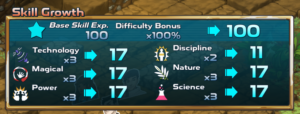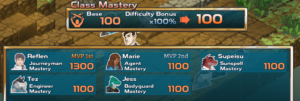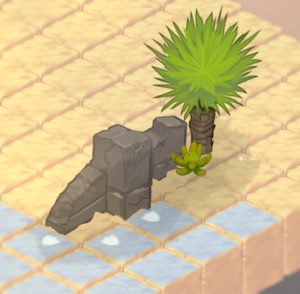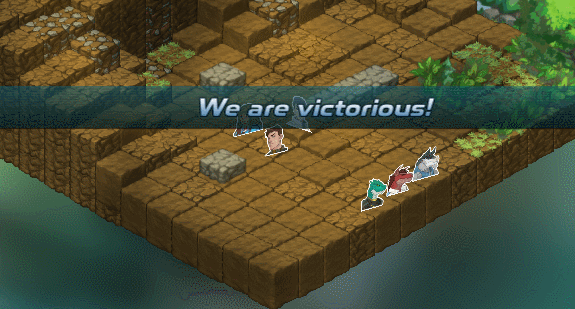Wait, is this only number six? I’ve been at this for a while, and… Okay, whatever. Six. Six is fine.
Today’s Music Choice
“As the Dust Settles” – the battle victory theme that plays while you’re getting a breakdown of your rewards. It’s fitting for this update. Volume note: For some reason, this song came out really loud, and I don’t know why. I even cut the volume to 60% in Premiere. So, be wary if you’re on headphones.
Progress Report
I’ve got a few small things to share this week. Mostly, I’m still adding workhorse UI stuff that is necessary, but ain’t gonna build itself. This week, most of that was the post-battle victory interface handling, where your party grows in strength and receives the spoils of war. I’ve pretty much figured out the method for doling out these rewards, so it was just a matter of showing it to the player.
It should be noted that, unlike many tactical games, your characters don’t gain experience/job points for every action they take. I’ve never really liked this design choice since it both encourages repetitive grinding while also making it trivially easy for non-attacking characters to “fall behind.” So, I’ve gone with a more predictable approach, where battles dole out a set amount of experience points (adjusted by an “encounter level” that will increase or decrease for over- or under-leveled participants), skill points, and class mastery to all units who participated, whether incapacitated at the end or not.
At the same time, though, there is a little variance for characters who were more proactive and involved in the battle: the battle will award bonus points to the “MVP” and “Second MVP” of the team. This can be exploited to divert extra bonuses to a certain character if desired, or it can just play out naturally. So, there are shades of the older style of “the most active character gets the lion’s share of experience,” but it’s more of a bonus stacked on top instead of completely depriving your healers, for instance. (Just try leveling up a healer in Shining Force or Disgaea if you really want to see where this decision comes from.)
Also, for most battles, you can choose the difficulty going in, which will affect the rewards. If you’re really struggling with a battle, you can turn down the difficulty to have an easier time, at the cost of additional rewards which you’ll have to make up later. But, if you’re feeling brave, you can turn up the difficulty instead, granting more rewards at the end. In turn, this means you can spend more time socializing with allies instead of taking on side jobs to build your character levels. That’s the idea, anyway. The difficulty rating mostly affects the AI’s aggression levels, and how much AP enemy units have, which means they can take more actions per turn or take turns more quickly. I’ll be fine-tuning that as I get into the real game loop.
So, first, your allies gain experience, as shown on the left. (Those graphics are definitely not final). It takes 100 EXP to gain a level, as usual, and if your character is a higher level than the battle’s “base” level, that value is reduced. Also, a character can gain a maximum of 199 experience from one battle, so it’s not possible for a low-level character to really explode in levels while tagging along in a single battle. They need to work for it.
Levels directly affect base stats (HP, SP, and combat skills like Melee or Gun proficiency), modified by the current class. Swapping classes changes up your characters’ stats, so you’re never gimped if you spend 20 levels as an Agent and decide to switch to a magic user, for instance.
 Second, characters gain skill points, which contributes to their skill levels (technology, magic, etc.) and in turn, lets them unlock new jobs or perform better on dispatch missions. This gets a little weird, so I’ll try to explain it. I’m also not 100% married to the idea, so I’ll see what my playtesters think about it. But, for now, here goes.
Second, characters gain skill points, which contributes to their skill levels (technology, magic, etc.) and in turn, lets them unlock new jobs or perform better on dispatch missions. This gets a little weird, so I’ll try to explain it. I’m also not 100% married to the idea, so I’ll see what my playtesters think about it. But, for now, here goes.
So, each class has skill biases: for instance, the Agent class is biased toward technology and discipline, while the Sunspell class is biased toward magical skill and nature. The idea is that your party composition pools up all these biases, and after the battle, the skill reward is divided up according to the skill pool. So, if your characters are heavy on technology-favoring classes, then they all gain more technology experience after the battle. This is a mild compromise for the “JP spillover” effect from Final Fantasy Tactics, where using an ability as one class makes your allies gain a tiny amount of JP in that class. In this case, though, it’s more about unlocking those other classes, instead of improving them.
Ideally, you will deploy a balance of classes to make your characters’ skill ratings rise evenly, but if you are trying to grow a certain skill more sharply than the others, you can stack your team to make that skill rise more quickly. Think of it like deploying allies who witness each other using magic, so they learn more about magic themselves.
 Third, class mastery is just added to your allies directly in their primary classes. This is also a base amount attached to the encounter (so later battles will give greater amounts), and is modified by difficulty and whether the character was an MVP. Mastery is spent to learn new abilities in that class.
Third, class mastery is just added to your allies directly in their primary classes. This is also a base amount attached to the encounter (so later battles will give greater amounts), and is modified by difficulty and whether the character was an MVP. Mastery is spent to learn new abilities in that class.
 Lastly, your party gains loot, cash, and new weapons/armor/accessories. These are not affected by the difficulty setting. Again, the UI is less “final” and more “it works so I’m moving on to something else for now.”
Lastly, your party gains loot, cash, and new weapons/armor/accessories. These are not affected by the difficulty setting. Again, the UI is less “final” and more “it works so I’m moving on to something else for now.”
 But, hey! All that good stuff is working, so I have the genesis of a game loop now! My next step will be designing a more “real” map, and passing it off to my testers so they can try out a mini game-loop and make sure nothing breaks. I’ve already started on this, working with a desert theme this time and using some of the new art assets I’ve picked up recently. Here’s a tiny preview when I was messing around. I haven’t added any polish or anything, and pretty much slapped it together right before writing this so I could test my map-switching function and make sure it worked correctly. As before, I’m going with a hand-painted look for the world, with sprite characters (still to come). What can I say; I have an aesthetic.
But, hey! All that good stuff is working, so I have the genesis of a game loop now! My next step will be designing a more “real” map, and passing it off to my testers so they can try out a mini game-loop and make sure nothing breaks. I’ve already started on this, working with a desert theme this time and using some of the new art assets I’ve picked up recently. Here’s a tiny preview when I was messing around. I haven’t added any polish or anything, and pretty much slapped it together right before writing this so I could test my map-switching function and make sure it worked correctly. As before, I’m going with a hand-painted look for the world, with sprite characters (still to come). What can I say; I have an aesthetic.
Next time, I’ll get into the process of putting a battle map together, as well as all the shortcuts I’ve afforded myself and stuff I need to be wary of. Fun, and educational?






